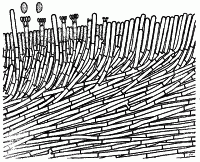|
 Phanerochaete monomitica Phanerochaete monomitica
SynonymsDuportella monomitica
Porostereum monomiticum
Hjortstamia monomitica
BiostatusPresent in region - Indigenous. Non endemic
Images (click to enlarge)
Caption: FIG. 4. Transverse section of Duportella monomitica, taken from the margin of a developing
fructification; showing projecting naked pseudosetae on right, submerged pseudosetae on left,
monomitic hyphal system and mode of branching of the genera |
Article: Cunningham, G.H. (1957). Thelephoraceae of New Zealand. XV. The genus Duportella. Transactions of the Royal Society of New Zealand 85(1): 91-99.
Description: Hymenophore pileate or resupinate, annual, sometimes reviving a second season, coriaceous,
developing at first as numerous orbicular sessile-umbonate colonies 5-10 mm diameter;
merging to form either broadly resupinate linear areas with reflexed margins, or remaining
resupinate, to 20 x 5 cm. Pilei narrowly effused-reflexed, to 5 cm wide, extending the length
of the upper margin of the fructifications, or sometimes imbricate; surface chestnut or more
usually umber or sepia, tomentose or strigose; hymenial surface at first radially sulcate,
fuscus, umber, or sepia, sometimes radiately rugose, at length tardily creviced, sometimes in
radiate series, when fertile becoming cinereous; margin thinning out, fibrillose, crenate, at
first broad and white or tan, becoming fawn, finally concolorous, free. Context sepia, shining
in section, 0.3-0.6 mm thick, intermediate layer of mainly parallel hyphae turning abruptly
into the hymenium; hyphal system monomitic; generative hyphae to 6 µ diameter, walls 0.2-0.5 µ
thick, yellow brown, darker when old and towards the base, branched, septate, without
clamp connexions. Hymenial layer a close palisade of basidia, paraphyses and scanty
projecting pseudosetae; in sterile plants composed of pseudosetae arranged in a loose
palisade. Basidia subclavate, 24-30 x 5-6.5 µ, 4-spored; sterigmata erect, slender, to 6 µ long.
Paraphyses subclavate, shorter and narrower than the basidia. Pseudosetae subclavate or
cylindrical, some with slightly inflated apices, walls usually naked, yellow brown, 0.25 µ
thick. Spores elliptical with lateral apiculi, or suballantoid, 6-7 x 3.5-4.5 µ, walls smooth,
hyaline, 0.1 µ thick.
Habitat: HABITAT: On bark of dead standing stems and trunks.
Distribution: DISTRIBUTION: New Zealand.
Notes: Separated from D. fulva, which it resembles most closely in macrofeatures, by the monomitic
hyphal system, usually naked pseudosetae, differently coloured freely septate generative
hyphae, and differently shaped spores. The hymenial surface is at first sepia or chocolate in
colour because of the copious development of pseudosetae. When plants become fertile the
colour changes to cinereous. The hymenium is tardily developed, at first appearing as
scattered groups of basidia and paraphyses lying among the pseudosetae; later, basidia and
paraphyses form a close palisade submerging the pseudosetae which then appear as a dense
zone in the subhymenium with a few projecting. Hyphae are somewhat scantily branched;
branches arise beneath septa, grow out at a wide angle, then turn parallel with the parent
hypha. The effused-reflexed pilei develop only upon the upper margins of fructifications
growing upon upright stems. They are uncommon, since most plants are either resupinate or
umbonate-sessile with free plane margins. Plants possess a disagreeable odour, even after
long keeping in the herbarium.
|